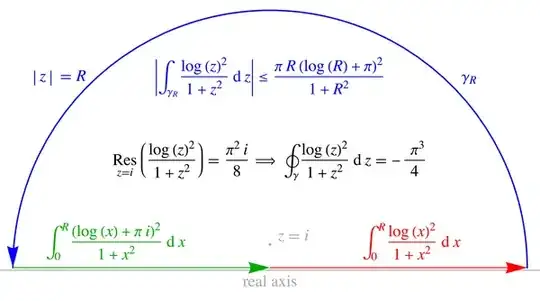George Arfken's book: Mathematical Methods for Physicists has the following problem in a chapter on contour integration:
$\displaystyle \int_0^{\infty} \dfrac{(\log x)^2}{x^2 + 1} dx$.
Their suggestion is to make the substitution $x \rightarrow z=e^t$. I'm not sure what they meant by this, but I tried making the substitution $x = e^t$, which turns the integral into:
$\displaystyle\int_{-\infty}^{\infty} \dfrac{t^2 e^t}{1+e^{2t}} dt$.
The hint is then to take the contour from -R to R, to R+$\pi i$, to -R + $\pi i$, to -R. Since this has a pole at $t = \pi i/2$, a Laurent series expansion about this point gives the residue as $i \pi^2/8$, so the contour integral equals $-\pi^3/4$.
I've been able to show that the integral along R to R + $\pi i$ and along -R + $\pi i$ to -R goes to zero by the ML inequality - the denominator grows exponentially but the numerator quadratically.
But at this point, I'm a bit lost as to what to do with the integral over Im $t = \pi$. Any help? The book gives the answer as $\pi^3 /8$.

\dfracas well. – Did Mar 12 '18 at 17:19